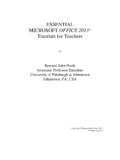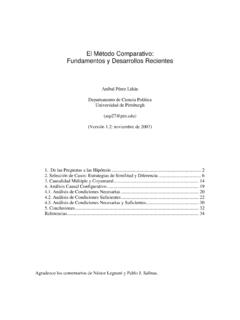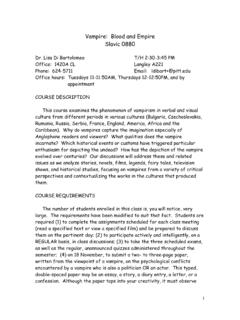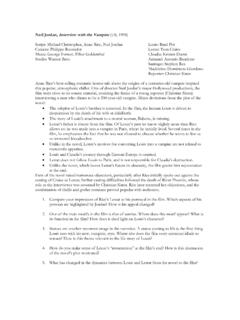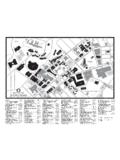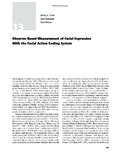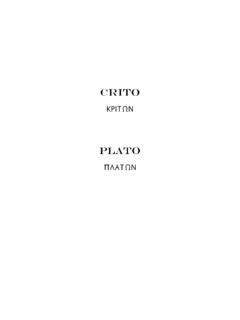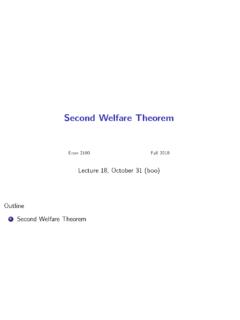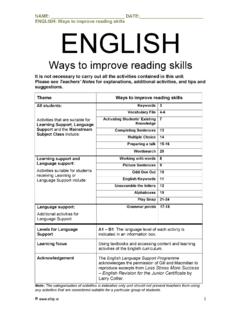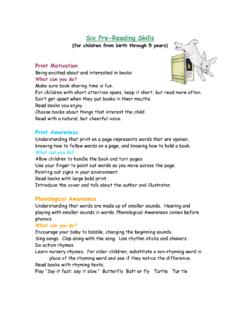Transcription of The Acquisition of Reading Comprehension Skill
1 13 The Acquisition of Reading Comprehension SkillCharles A. Perfetti, Nicole Landi, and Jane OakhillHow do people acquire Skill at comprehending what they read? That is the simple ques-tion to which we shall try to make a tentative answer. To begin, we have to acknowledgesome complexities about the concept of Reading Comprehension and what it means todevelop : Simple Ideas about Reading ComprehensionWe can expect the Comprehension of written language to approximate the comprehen-sion of spoken language. When that happens, then Reading Comprehension has devel-oped, for practical purposes, to its limiting or asymptotic level. (It is possible for readingcomprehension Skill to develop so as to exceed listening Comprehension Skill , but that isanother matter.) All other limitations are imposed by linguistic abilities, relevant knowl-edge, and general intelligence.
2 If we make things more complex than this, we push ontothe concept of Reading Comprehension all these other important aspects of cognition, withthe muddle that results from conceptual simple idea that the Acquisition of Reading Comprehension is learning to under-stand writing as well as one understands spoken language has empirical justification. Atthe beginning of learning to read, the correlations between Reading and spoken languagecomprehension are small (Curtis, 1980; Sticht & James, 1984). This is because at thebeginning, children are learning to decode and identify words, so it is these word-readingprocesses that limit Comprehension . However, as children move beyond the beginningsof learning to read, the correlations between Reading Comprehension and spoken languagecomprehension increase and then level out by high school (Sticht & James, 1984).
3 Aschildren learn to read words, the limiting factor in Reading Comprehension shifts fromword recognition to spoken language Comprehension . For adult college student samples,SSR13 11/27/04 10:54 AM Page 227the correlation between scores on Reading Comprehension and listening comprehensiontests reaches r =.90 (Gernsbacher, 1990).If this were the end of the story, then the study of Reading Comprehension would fold completely into the study of language Comprehension . However, there is probablymore to the story. First are some methodological considerations. Studies that compare Reading Comprehension with listening Comprehension avoid the confounding of materials, making a clean comparison between the same or equivalent passages with only the modality (speech or writing) different.
4 But for most people, what they usually hear is different in content and style from what they read. These differences extend through formal, semantic, and pragmatic dimensions of language. Thus, what is necessary for experimental control is problematic for authenticity. Second, one must make a decision about the speech rate in such comparisons. What is the proper rate for a comparison with Reading ? The listener s preference? The speaker s preference? A rate equal to the Reading rate? Finally, we take note of a more interesting possibility;namely that literacy may alter the way people process spoken language (Olson, 1977). If so, this would boost the correlation of listening and Reading Comprehension in accept, approximately and in an idealized form, the assumption that Reading com-prehension is the joint product of printed word identification and listening comprehen-sion, an idea famously asserted by Gough and Tunmer (1986) as a simple view of , we also must assume that learning to read with Comprehension brings enoughadditional complexities to justify a chapter on how that Framework for ComprehensionComprehension occurs as the reader builds a mental representation of a text message.
5 (For a review of current ideas about Reading Comprehension in adults, see Kintsch &Rawson, current volume.) This situation model (Van Dijk & Kintsch, 1983) is a repre-sentation of what the text is about. The Comprehension processes that bring about this representation occur at multiple levels across units of language: word level, (lexicalprocesses), sentence level (syntactic processes), and text level. Across these levels, processesof word identification, parsing, referential mapping, and a variety of inference processesall contribute, interacting with the reader s conceptual knowledge, to produce a mentalmodel of the of cognitive architecture emerge in any attempt to arrange these processesinto a framework for Comprehension . The various knowledge sources can interact freely,or with varying degrees of constraint.
6 For example, computing simple syntactic representations (parsing) probably is more independent of nonlinguistic knowledge thanis generating inferences. These issues of cognitive architecture are important, complex,and contentious; we will not discuss them further. Instead, we assume a general framework that exposes the processes of Comprehension without making strong assump-tions about constraints on their interactions. Figure represents this A. Perfetti, Nicole Landi, and Jane OakhillSSR13 11/27/04 10:54 AM Page 228 Within Figure are two major classes of processing events: (1) the identification ofwords, and (2) the engagement of language processing mechanisms that assemble thesewords into messages. These processes provide contextually appropriate word meanings,parse word strings into constituents, and provide inferential integration of sentence information into more complete representations of extended text.
7 These representationsare not the result of exclusively linguistic processes, but are critically enhanced by otherknowledge this framework, acquiring Skill in Reading Comprehension may include devel-opments in all these components. However, if we focus on Reading , as opposed to lan-guage Comprehension in general, then the unique development concerns printed other processes apply to spoken as well as written language. Children must come toreadily identify words and encode their relevant meaning into the mental representationthat they are constructing. Although in a chapter on Comprehension , we avoid dwellingon word identification, we cannot ignore it completely. Comprehension cannot be successful without the identification of words and the retrieval of their meanings. BothThe Acquisition of Reading Comprehension Skill229 ComprehensionProcessesGeneralKnowledgeLi nguisticSystem Phonology, Syntax, MorphologyLexicon Meaning Morphology SntaxOrthography Mapping to phonologySituationModelTextRepresentatio nParserInferencesMeaning andForm SelectionWo rdRepresentaionWo rdOrthographicUnitsPhonologicalUnitsVisu al InputIdentificationFigure components of Reading Comprehension from identifying words to comprehend-ing texts.
8 Adapted from Perfetti (1999).SSR13 11/27/04 10:54 AM Page 229children and adults with low levels of Comprehension may also have problems with lexicalrepresentations, a point to which we shall return later. First we address the sentence andtext-level processes that are the defining features of and mental modelsThe atoms of meaning are extracted from sentences, aggregated through the Reading ofother sentences of the text and supplemented by inferences necessary to make the text coherent. The bare bones of the text its literal meaning or text base consist ofpropositions (nouns and predicates or modifiers) derived from sentences. They are largelylinguistic, based on the meanings of words and the relations between them (predicatesand modifiers), as expressed in a clause. The reader s mental model can be considered an extended set of propositions that includes inferences as well as propositions extracted from actual text sentences.
9 A mental model also may represent text infor-mation in an integrated nonpropositional format (Garnham, 1981; Johnson-Laird, 1983), preserving both stated and inferable spatial information in the form of spatial analogues (Glenberg, Kruley, & Langston, 1994; Haenggi, Kintsch, & Gernsbacher,1995; Morrow, Greenspan, & Bower, 1987). More typical are texts that are organized,not around space, but about time (Zwaan & Radvansky, 1998). Research has clearlyshown that readers are very sensitive to the temporal dimension of narratives (Zwaan,1996).With this framework of skilled Comprehension , we can ask about the Acquisition ofcomprehension Skill and differences in Comprehension Skill . What accounts for compre-hension failure? Are the difficulties in Comprehension localized in the processes of infer-ence that are needed for the situation model?
10 Or in the processes of meaning extractionthat are required to represent the propositions of the text? To address these questions, weexamine studies that compare readers who differ in Comprehension Skill . In most research,the assessment of Comprehension is a global one, based on readers answers to questionsfollowing the Reading (usually silent, sometimes oral) of very short texts. (For a rareexample of an assessment based on the differentiation of Comprehension components seeHannon and Daneman, 2001.)We first consider those processes that go beyond understanding the literal meaning ofclauses and sentences. We begin with processes commonly viewed as critical to produc-ing higher-level Factors in ComprehensionAmong the components of the Comprehension framework are three that we highlight inthis section: sensitivity to story structure, inference making, and Comprehension begin with the last two, which have been proposed as important sources of compre-hension development and Comprehension A.
